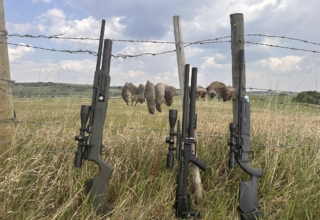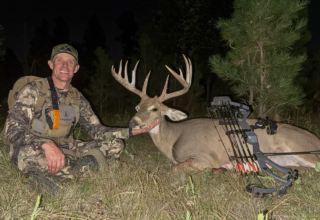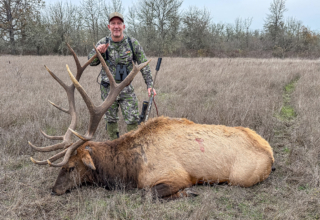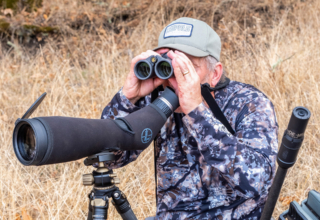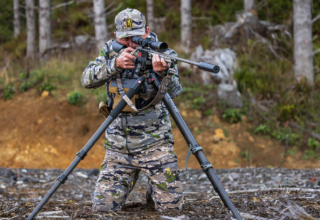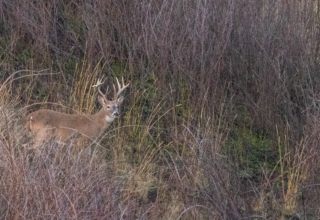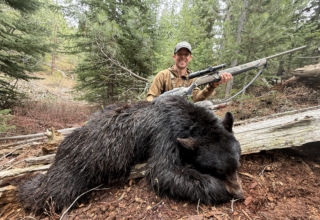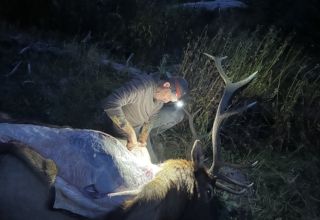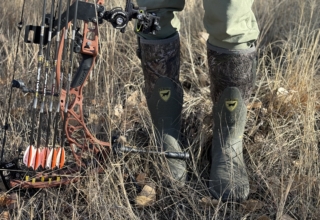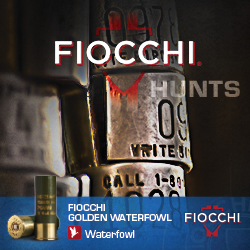Outdoor legend Scott Haugen makes his 16th safari with only two animals, sable and roan, on his plains game hit list.
by Scott Haugen
Our class project was to craft an animal out of papier-mâché. I chose an African lion. “Someday I want to hunt a lion,” I told my teacher. I was in 4th grade. The year was 1974.
While its yarn-crafted mane is tattered and holes have formed here and there, that paper lion still sits on a shelf in my house. I see it every day. No bigger than a milk crate, it’s a vivid reminder of how important it is to have dreams at a young age. And how important it is to chase those dreams.
I’ve been to Africa and shot a lion, five to be exact, two of which were man-eaters. On my first African safari in 1993, I went with a list of plains game I wanted to hunt. Kudu were at the top. They carried a trophy fee of only $700 at the time. Actually, sable were number one on my wish list. However, they had a price tag of $12,000. A roan was number two, and it cost over $15,000. That’s why a Southern greater kudu moved into the top position.
Thirty-one years later, I had the opportunity to hunt my two most prized African antelope, sable and roan. I had actually hunted sable twice before. Once in Zimbabwe, but we quickly discovered poachers had wiped out entire herds. I also hunted them in Namibia. We found sable, but they were on a neighboring property that was closed to hunting.
Sable are one of Africa’s most iconic animals, referred to as the prince of Africa. As a young man, I was captivated by how writers like Theodore Roosevelt and Robert Ruark, among others, attempted to capture their beauty in words. The jet-black hide of bulls, accented with stark white markings on the belly and face, makes them a prized big-game animal among many.
Scimitar-shaped horns sweep over their backs. Their thick chest, narrow waist, and hindquarters, combined with sharply tapered legs, are unique, giving them a sturdy, athletic, horse-like appearance. Their beauty and physique command your attention. A mature bull will weigh 500 pounds.

From the 1950s through the 1970s, tsetse fly outbreaks significantly reduced sable numbers throughout their range. By the 1980s, sable numbers were on the rebound.
Throughout my 16 safaris to the Dark Continent, the ancient rock art of sable has distinctly stood out in many places. The clarity of this animal’s anatomy leaves no question as to what indigenous peoples were creating.
Unlike many of Africa’s antelope, sable routinely stand their ground when confronted by predators. When attacked, sable can impale lions, leopards, and other predators with their sharp, curving horns. The fearlessness of standing their ground frequently leads to the sable’s demise at the hands of poachers, making them easy targets when cornered with dogs.
Sable and roan are edge species, living where grasslands and wooded savannas overlap. Both animals depend on water, visiting pools or small streams to slake their thirst. They graze on green grass and also rely on dry grasses, forbs, and leaves.
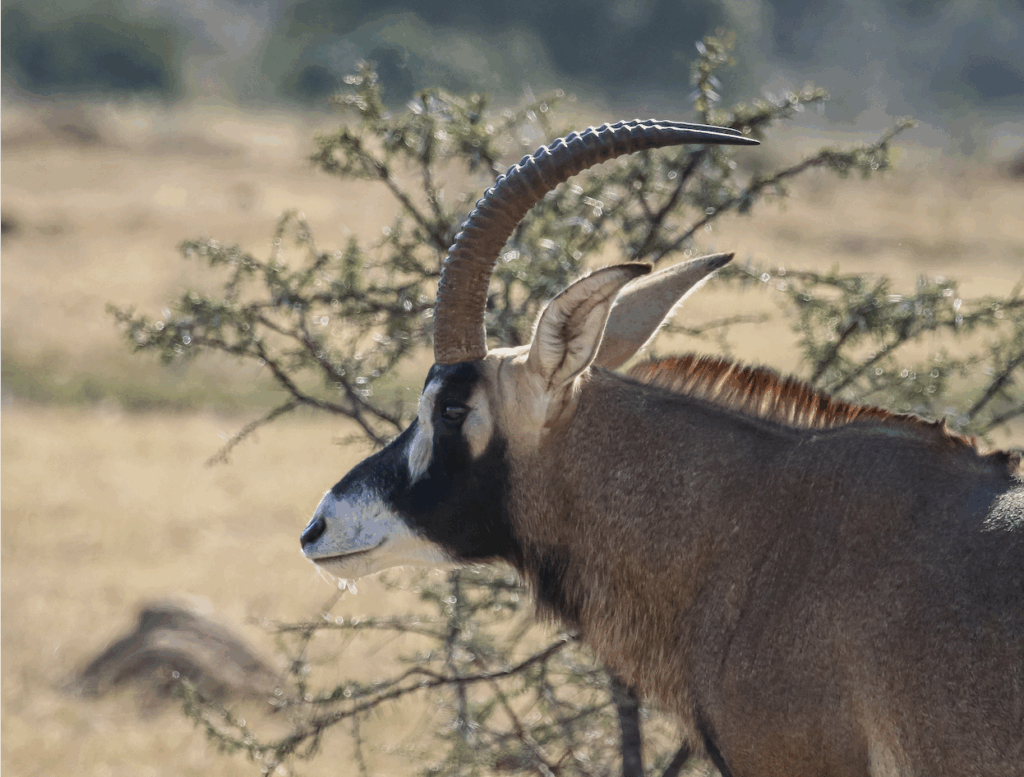
The needs of both sable and roan find them living in lowland habitats from Tanzania to South Africa, meaning they’re often in competition with farmers. Farming has led to the degradation of much of their habitat. Today, private landowners and parks are solely responsible for decades of effort that have restored sable and roan populations, thus providing more hunting opportunities than existed 30 years ago.
In the 1990s, a bull sable with 36-inch-long horns was the holy grail. Today, that number has increased to 40 inches. On a hunt last year in South Africa, my goal was to beat the 40-inch mark.
I was hunting with Charl le Roux, owner and operator of Rosedale Safaris in South Africa. I’d hunted with Charl before, near Port Elizabeth. He has access to some of the most diverse habitats I’ve hunted, and the quality of animals is among the best I’ve seen. Giant East Cape kudu, nyala, waterbuck, and eland are just the start. When I laid eyes on some massive sable the last time I hunted with Charl, I vowed to return.
I only wanted to hunt two animals on this safari, and a sable was my top choice. Roan was second, but I wasn’t sure they’d be in the cards. I took four trail cameras, and early in the hunt, Charl and I set them in wooded areas with water. We were hunting in the Karoo region. It was one of the wettest falls they’d had in decades. Grasses were green, water holes full, and creeks were flowing in several drainages throughout the Karoo. I’d hunted this region multiple times over the past 25 years, and this was the greenest I’d ever seen it.
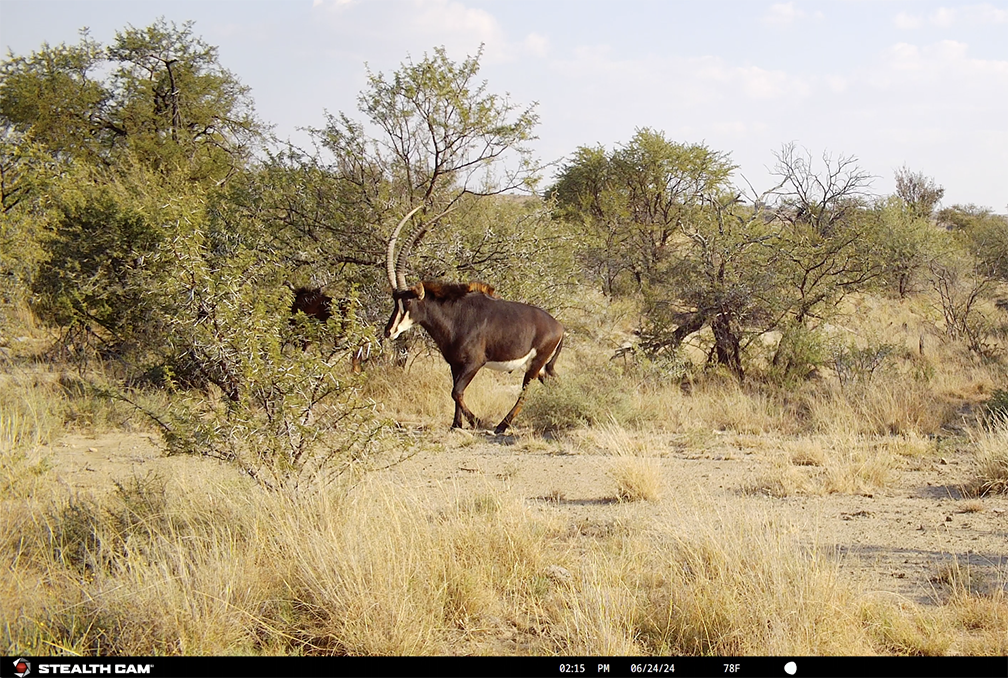
We captured sable and roan on trail cameras as they came to water in various areas. One creek in particular became our target spot, as some big bulls—both sable and roan—routinely visited it during the day.
On day three, le Roux took two friends for kudu in the mountains. I hunted with one of his ace guides, Pieter Zwiegelaar. I wanted a sable in the worst way. Even if we saw a roan, I’d pass because I didn’t want to get distracted from the prince of Africa. I almost ate my words, as Pieter got excited about a monster bull roan we watched through a spotting scope at first light. The bull was over a mile away. It was with two other bulls. They were feeding and had no idea we were there. We left them alone, hoping we’d be able to locate them once the sable hunt came to a close.
The Karoo is a semi-arid landscape covering over 150,000 square miles of South Africa, approximately one-third of its total area. We continued glassing, the rising sun at our backs. No sable were spotted, so we hiked through a shallow valley and on to another rise.
A small herd of sable cows and calves fed from a wooded draw into nearby green grass. Then Pieter spotted two bulls. They weren’t shooters. The land before us was rolling grasslands atop gently undulating hills with sparsely wooded draws in the bottom.
As temperatures warmed and animals moved into the wooded draws for shade, we went for a walk. We concentrated our efforts near where two trail cameras had been routinely catching sable and roan.
Pushing through sparse grass and bushes covered in thorns, the going was slow. The experience reminded me of hunting river bottom whitetails back home, until we laid eyes on a big bull sable.
The bull stood facing us, head sharply turned over its right shoulder. It had no idea we were there. “It’s a nice bull, about 40 inches, but let’s keep looking,“ whispered Pieter. The fact that we’d just passed on what’s considered the magic mark for a prized sable left me questioning what else might be out there. “I think we can find a bigger bull,“ Pieter consoled. He knew what I was thinking.
For More Awesome Africa Hunt Content, CLICK HERE!
We’d caught three bull sable on a trail camera, Pieter assured me, that were bigger than the one we’d just seen. Those were the bulls we were looking for. I thrive on the challenge of closing the deal on a mature animal. I’d waited over 40 years for this hunt. I was in no rush.
We studied a couple more bulls in the distance. They were smaller than the first. “Let’s finish walking this little ravine, then we’ll take a lunch break,“ Pieter said.
We went 15 yards when Pieter instantly stopped. I almost bumped into him. He started glassing in front of us. I had no view. “This is a massive, massive bull,“ Pieter whispered, looking through the thorn bush, his breath becoming shorter. “I need to see how long the horns are, though.”
The bull stood in a narrow trail in the trees. Looking at it through binoculars, its mass instantly caught my attention. It was the thickest-horned sable we’d seen. The leaves on the trees hid over half the bull’s headgear. Pieter got low and saw the bull’s horns when it turned sideways.
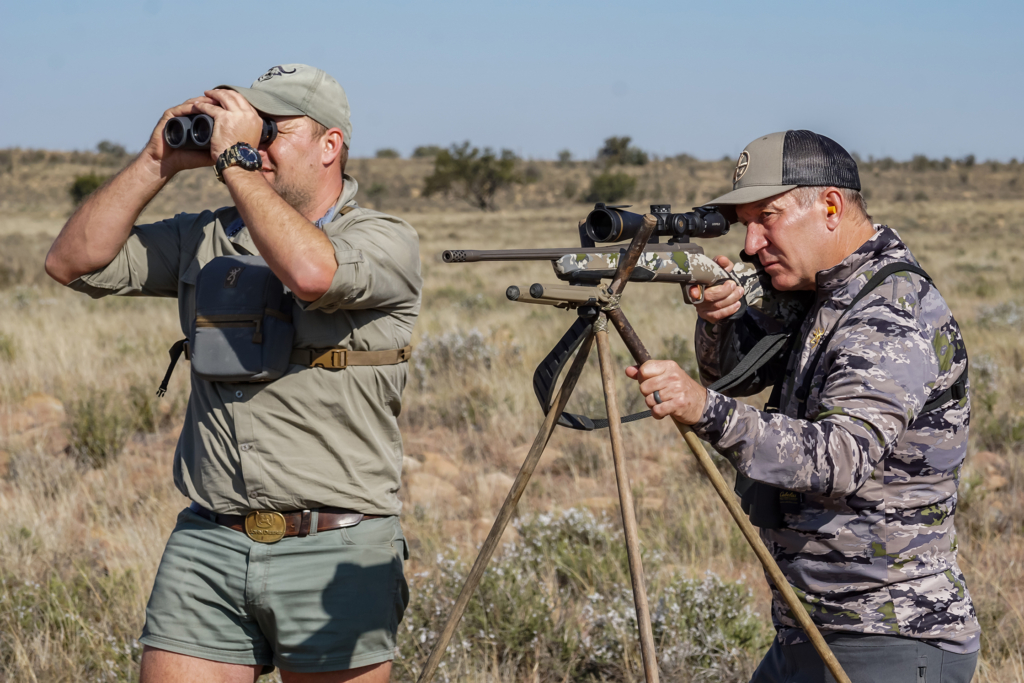
Slowly, Pieter stood and began erecting the shooting sticks. “This is a giant bull, and you need to shoot it right now,“ he said quietly but with urgency. The Browning 6.8 Western was solid in the sticks. The distance was 177 yards. Pieter confirmed the distance with his rangefinder. “Hit it square in the chest,“ Pieter whispered.
The whack of the bullet was solid, as it always is when entering the brisket. The bull took off running through the trees, then sprinted into the open. For the first time, I laid eyes on its horns. Long, sweeping, glistening in the African sun; it was an image I’ll never forget. The bull ran 40 yards and tipped over.
Wrapping my hands around the bases of the bull’s horns, it was even bigger than I’d imagined. The horns were sharp. Its contrasting white and black features are striking. It was one of the most awesome-looking animals I’d ever seen. Pieter and I shook hands and embraced. It was a special moment for both of us.

“In all my years as a PH, this is the biggest sable I’ve ever seen taken,“ Peter shared. The horns measured an astounding 45 inches long with 10-inch bases; a true bull of a lifetime.
We took the sable to the skinning shed, grabbed a quick bite to eat, and headed back out in search of roan. We saw two small bulls and some cows. That night Pieter grilled fresh sable tenderloins over an open fire. It was delicious.
The following morning, we were on a high spot, glassing for the three roan we’d seen the day prior. We hunted all day. Finally, minutes before dark, we found what we were looking for. We tried catching up to them, but failed. Sleep did not come easily that night.
On the final day of the hunt, we were in the hills well before daylight. We laid eyes on some nice bulls, but the big one eluded us. Finally, with less than 30 minutes of daylight left, Pieter spotted the bull we’d seen on day one of the sable hunt.
We scrambled, ran, and crawled, managing to close the distance. The two smaller bulls were still with the big bull. They saw us, spooked, and ran. I thought it was over.

“Quickly, move up to that rise and get ready,“ Pieter urged. “Your bull hung back and is standing behind those trees,“ he pointed. We got set up, and through the scope I found the bull glaring in our direction. It was too brushy to shoot.
We both got a range of 195 yards. Finally, the bull stepped to the edge of the tree. One bullet behind the shoulder and the 600-pound roan was down. It was the biggest roan Pieter had ever guided a hunter to.
Approaching the downed bull was surreal. There was no shouting. No celebrating. No animated high-fives. This was a moment I’d anticipated for years, one I was never sure I’d realize. I struggled to find words to express my feelings. I failed.
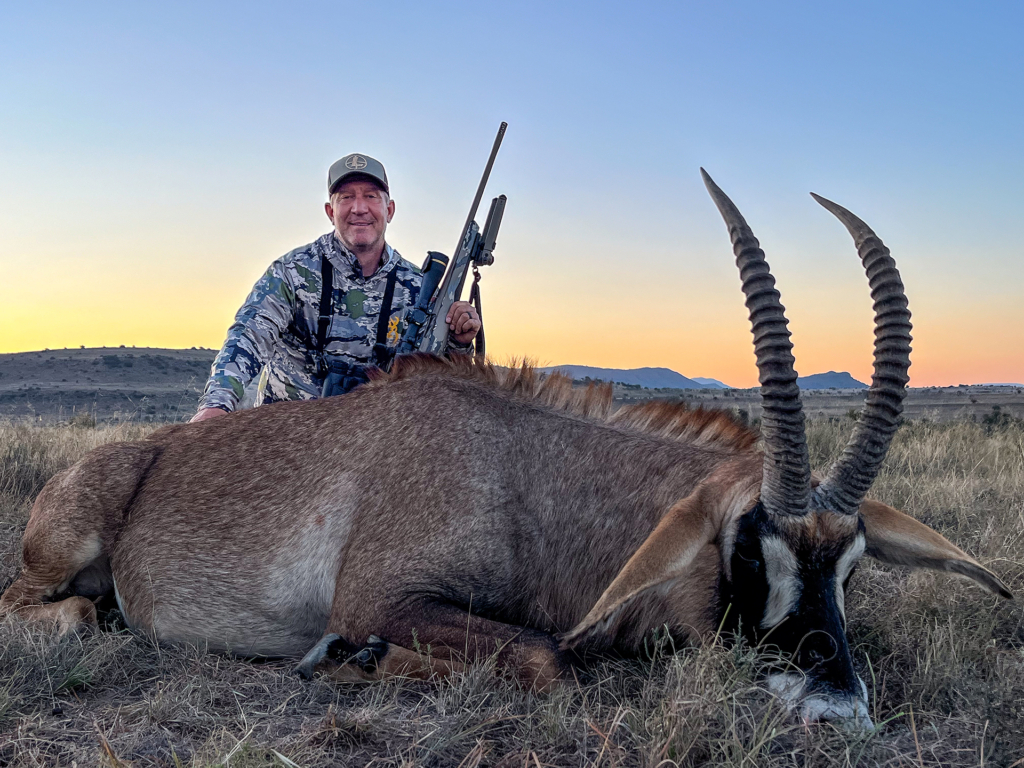
A trip halfway around the world. Two shots were fired, and two of the most magnificent animals I’d ever laid eyes on were down. Life was good.
Africa Bonus: The Gear
Quality optics and a flat-shooting rifle are key pieces of gear for hunting open-country sable and roan. They’re thick-chested antelope, and their muscles are dense.
I shot Browning’s X-Bolt 2 Speed rifle in a 6.8 Western. I’d seen this caliber perform well on Roosevelt elk, which are much bigger than sable. I’d also shot bear with it and seen kudu, gemsbok, wildebeest, and other challenging African game cleanly taken with it. It’s a tack-driver, one I have utmost confidence in, especially when shooting Browning’s Long Range Pro Hunter 175 grain Sierra Tipped Gameking bullets.
The rifle was equipped with a Leupold VX-6HD scope and a customized CDS dial specifically tailored for this load. Just range, dial, and shoot. The 3-18×44 scope was a perfect fit for an African plains game hunt. The clarity and ease of use of this scope are very impressive. I’ll be using this setup on big game hunts in North America.
Leupold’s SX-4 Pro Guide 15-45×65 spotting scope was essential on this hunt. The spotter’s clarity allowed the PH to give me a crash course in judging sable and roan at great distances. “I’ve used a lot of spotting scopes over the years and this is the best I’ve seen,“ shared my PH Pieter, more than once during our hunt.


